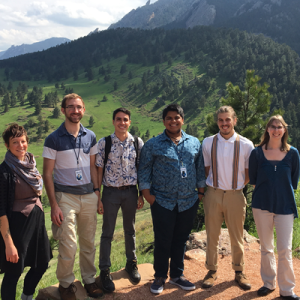4th NEON undergraduate internship program starts off strong
June 16, 2016
Six enthusiastic undergraduate interns arrived at NEON headquarters in May to participate in NEON’s fourth annual undergraduate internship program. The students will be in Boulder for 11 weeks gaining real world experience contributing to a variety of NEON projects. Here’s a brief look at who they are and what they are working on:
Adrián Lugo Bendezú from San Juan, Puerto Rico attends the University of Puerto Rico Río Piedras Campus and is majoring in Integrative Biology. Traditionally, expensive software tools have been a necessity for working with hyperspectral data; Adrian is working on developing a software tool that will allow QGIS (an open source software package) to open, read, and use NEON’s hyperspectral data.
Frances Janz is from Westminster, Colorado and attends the University of Colorado at Boulder, majoring in Ecology & Evolutionary Biology (EBIO) with a minor in Philosophy. Her project focuses on determining whether there are differences in the types and amounts of organisms found in soil collected at NEON field sites using two different soil sampling methods. This analysis will help NEON scientists make more informed decisions on the best soil sampling procedures at field sites.
Ian Flores Siaca from Carolina, Puerto Rico also attends the University of Puerto Rico, Rio Piedras Campus. He is majoring in Biology with a minor in Sociology. This summer he is focusing on creating novel data analysis and visualization applications for NEON’s field-based organismal data that will be shared with NEON’s data user community.
Justin Ripley is from Golden, Colorado. He is an Environmental Engineering major at The Colorado School of Mines. This summer, Justin is working in NEON's Calibration and Validation lab analyzing the uncertainty associated with the collection, measurement and storage of pressurized gases used for the “state-of-health” testing of carbon dioxide sensors mounted on the NEON towers.
Kyle Feldman of Crownsville, Maryland is a Bard College Biology major. Kyle is working closely with NEON scientists to help analyze the potential effects that Federal Aviation Administration (FAA) safety lighting may have on the flux tower sensors that analyze radiation (visible light and heat). Currently, there are two NEON towers required to have FAA safety lighting due to their height.
Sharon Williams from Dillon, Montana is a Geology major at the University of Montana Western with a focus in GIS (Geographic Information Systems) mapping. She is creating dynamic web maps of each NEON domain to be used by field operations staff across the NEON network. The maps will include key geographic markers such as tower and aquatic site locations, field sampling locations, boundaries, pictures and more.
In their first few weeks at NEON, the interns have noted how welcoming and diverse the staff are at NEON. Sharon commented that “because so many people here specialize in things I know nothing about, every interaction I’ve had has been very informative and interesting!” and Adrian added, “NEON headquarters is a community of passionate, committed, and friendly people. Meeting with leading scientists and professionals in the field is a unique opportunity. We are a diverse group working on widely different projects that are all part of the overall mission.”
We also asked them about their goals for this summer, and the common themes were 1) To do real research and science 2) Improve their computer programming skills 3) Learn a lot and make an impact. We have no doubt they will be able to accomplish these goals, and we look forward to sharing the outcomes of their projects and experiences at the end of the summer.
Know a student who might be interested in becoming a NEON intern? Learn more about NEON’s undergraduate internship program.
